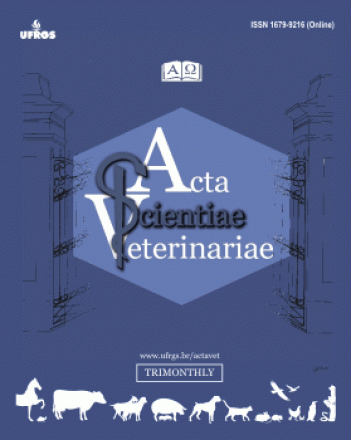Endocrinologia e controle da vitelogênese em carrapatos
Acta Scientiae Veterinariae
Endocrinologia e controle da vitelogênese em carrapatos
Autor Correspondente: Adriana Seixas | [email protected]
Palavras-chave: tick, vitellogenesis, embryogenesis, hormones, enzymes
Resumos Cadastrados
Resumo Inglês:
Background: Ticks are distributed worldwide, with impacts on human and animal health. The cattle tick Rhipicephalus
(Boophilus) microplus is the main parasite that affects livestock in tropical and subtropical regions of the world, causing large
economical losses. Tick control methods are based on the application of chemical acaricides, which has resulted in selection
of resistant ticks and a potential risk of environmental pollution and food contamination. Vaccines have showed to be a
feasible tick control method that offers a cost-effective, environmental friendly alternative to chemical control. However, more
than ten years after the commercialization of the first vaccine against ticks, the identification of tick-protective antigens
remains a limiting step in the development of an efficient formulation that would avoid the use of chemical acaricides. So, the
study of parasite biology and understanding physiological mechanisms could be a good strategy to find new targets for an
efficient vaccine.
Review: It was reviewed the main insights about the reproductive process in ticks, emphasizing the hormonal control of
vitellogenesis and enzymes involved in vitellin processing during embryogenesis. The processes of vitellogenesis and
embryogenesis have been studied in various organisms, particularly in cockroaches, flies and ticks. Although the roles of 20-
hydroxyecdysone (20E) and juvenile hormone have been well characterized for vitellogenesis in insects, we know much less
about the hormonal control of vitellogenesis in ticks. Initially, it was hypothesized that juvenile hormone was involved in tick
vitellogenin-synthesis. However, more critical studies uncovered no evidence for the occurrence of juvenile hormone or
juvenile hormone-like molecules in several tick species. Current research shows that in ticks, it appears that ecdysteroids, and
not juvenile hormone, regulate the expression of the vitellogenin gene and the synthesis and release of vitellogenin protein
into the hemolymph. In general, the carbohydrate, lipid and amino acid composition of tick vitellogenin is similar to that of
insect vitellogenin. Once in the hemolymph, oocytes uptake vitellogenin through receptor-mediated endocytosys. However,
there are different strategies to control vitellogenin synthesis and uptake by ovary in ixodide ticks. In the oocytes, vitellogenin
is partially processed in the endosomal compartment and then stored as vitellin, the main reserve of protein for embryo
development, in specialized organelles, the yolk granules. Embryo development depends on the availability of yolk material
stored into oocytes. So, the characterization of molecules involved in vitellogenesis and embryo development contribute to a
better understanding of the tick parasite physiology. During embryogesesis, acidic enzymes are responsible for the availability
of this material and embryo nutrition. The Vitellin-Degrading Cysteine Endopeptidase (VTDCE), Boophilus Yolk Pro-Cathepsin
(BYC) and Tick Heme Binding Aspartic Proteinase (THAP) are enzymes involved in vitellin hydrolysis in R. microplus eggs.
These enzymes are produced by gut and fat body and transported through the hemolymph to be internalized into the oocytes
and then play their role in tick embryo nutrition. As VTDCE, BYC and THAP are involved in an important physiological
process, their potential as targets in an anti-tick vaccine is an attractive research topic. With this objective, various enzymes
have been tested in native or recombinant forms as candidate immunogens to a multiantigenic anti-tick vaccine.
Conclusion: Significant advancements have been made in recent years on understanding the tick reproductive process, and
some molecules that can be possible targets for development of new tick control strategies have been characterized.

